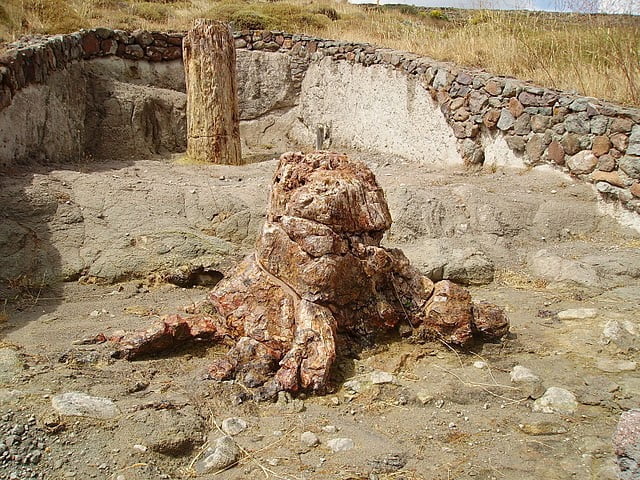
The Greek island of Lesbos is notable for it’s Petrifed Wood forest, a protected national monument. The forest is located on the western portion of the island and was formed from the Late Oligocene to Lower–Middle Miocene and consists of silicified remnants of a sub-tropical forest that going back 20–15 million years ago.
Recent discoveries in the rich Petrified Forest have been electrifying. First was the rare discovery of a spectacular 19.5 meter long log , with accompanying roots, branches, and trees, the only found to date in over 25 years of excavations. Weeks later, the excavators uncovered over 150 more petrified wood logs and petrified wood stumps including conifers, fruit producing trees, sequoia trees, pine, palm, cinnamon and oak trees. The finds were all discovered in the same pit.
The excavation team has been working since 2013 excavating along a 20km stretch of highway and have made 15 major finds, but these all pale to this most recent discovery, which was actually the result of a lucky accident. One the excavators notices a leaf in a stretch of the highway about to get asphalted, and halted the road work.
The park has been designated a UNESCO Global GeoPark. There is an excellent museum well worth visiting. If you visit the park, remember that the removal and transfer of fossilized material is prohibited by law. The forest includes six parks. The fossilized trees include mainly huge sequoias and primitive pine trees in an ecosystem closest to the coniferous forests of North America.
While we haven’t been to Lesbos we do have some of our own spectacular Petrified Wood finds available for sale in our catalog.
Top image is of Petrified Forest on the Island of Lesbos, Greece, by C messier – Own work, CC BY-SA 3.0, https://commons.wikimedia.org/w/index.php?curid=8926168

Petrified Wood near Sigri, Island of Lesbos, Greece. Photo By Rutger2 at nl.wikipedia, CC BY 2.0, https://commons.wikimedia.org/w/index.php?curid=3222318
Petrified Wood, Island of Lesbos, Greece. Photo by Signy – Own work, CC BY-SA 3.0, https://commons.wikimedia.org/w/index.php?curid=11642494


Unstable temperature and relative humidity, different rates of expansion and contraction, salt movement, living plant roots and other factors cause cracking in fossil wood. In order to prevent dirt and contemporary vegetation from accumulating into the cracks, and prevent breakages, solutions of especially prepared consolidants are injected in surface cracks. [Kyriazi, E. and Zouros, N. (2008) ‘Conserving the Lesvos Petrified Forest’, Studies in Conservation 53 (Supplement-1 – Conservation and Access: Contributions to the 2008 IIC Congress), London, p. 141-145] The beautiful rose colours of the silicified fossil wood in this picture are due to the presence of manganese ions. Photo by E.Kyriazi – Own work, CC BY-SA 4.0, https://commons.wikimedia.org/w/index.php?curid=44800562